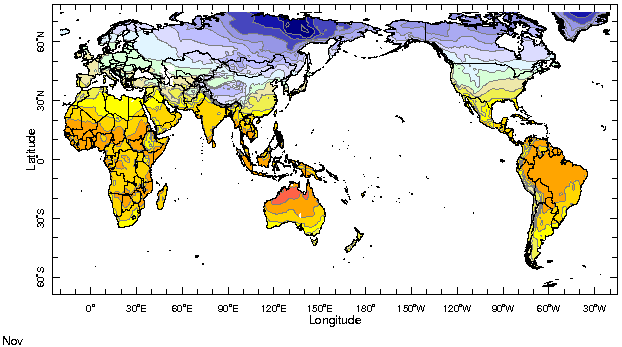|
IRI Climate Digest
December 2001
November Global Climate Summary
Climatological Background
During November, the Northern Hemisphere mid-latitude storm tracks increase in strength, while monsoon systems in South Africa, Australia, and South America expand southward following the maximum solar heating. Tropical storm activity winds down in the North Atlantic, the North Pacific and northern Indian Oceans.
Monthly Mean Temperature (1961-1990), data from the Climate Research
Unit, University of East Anglia


Monthly Mean Precipitation (1961-1990), data from the Climate Research
Unit, University of East Anglia


Temperatures
Unusually warm temperatures continued to prevail over much of the continental landmasses, except for Australia.
Asia: Large areas of western China, central Asia, and Siberia experienced warm conditions. Southern Asia has experienced several consecutive months of unusally warm conditions.
North America: Near-record warm temperatures occured over the eastern and central regions of Canada and the U.S. Regions of the southwest U.S., northwest Mexico, and eastern Canada were in their third consecutive month of well above average temperatures.
South America: Equatorial South America and areas of Brazil continued their third month of warmer-than-average conditions.
West Africa: Continuing the trend of past months, unusally warm temperatures extended along the Guinea coast countries north along the west coast of Africa into Mauritania.
Indonesia: Warmer-than-average temperatures continued in Indonesia.
Australia: Australia again provided the lone exception to the trend towards warm anomalies.
Temperature Difference from the 1961-1990 mean, with data
from NCEP Climate Prediction Center, CAMS.


Precipitation
Drought continued in Southwest Asia and Sri Lanka.
Central America and Caribbean: Then-tropical storm Michelle brought heavy rainfall to Honduras and, as a hurricane, resulted in heavy rainfall over Cuba.
South America: Beneficial, above average rainfall fell across much of central and southern Brazil. Precipitation was near to above average across the Pampas in Argentina which continues to be affected by previous flooding. Unusually dry conditions continued across much of Colombia for the third consecutive month.
North America: Unusually dry conditions persisted along the east coast of the United States with Virginia, Deleware and New Jersey recording their driest Sep-Nov season on record. Pacific storms brought above average precipitation to the western US and helped to ease prior drought conditions in the Pacific Northwest. Eastern and central Canada continued to be unusually dry,as did southern Alaska.
Africa: Abnormally dry conditions were found throughout Madagascar, Tanzania, Malawi, and northern sections of Mozambique, and extended along the western equatorial coast of Africa from Equatorial Guinea to northern Angola. It was unusually wet throughout most of southern Africa, in Kenya, and in western sections of the Democratic Republic of Congo.
Southwest Asia: Rainfall amounts continued to be well below average in northwest Iran and agriculturally sensitive regions of Afghanistan.
Australia and New Zealand: In New Zealand, the rainfall pattern was reversed from October, with the November rainfall near-average to wet in the south island and near-average to dry in the north island.
Sri Lanka: Rainfall deficits continued for Sri Lanka.
Precipitation Difference from 1961-1990 mean, with data
from NCEP Climate Prediction Center, CAMS-OPI.


Oceanic Conditions
Tropics: Sea surface temperatures (SSTs) in the equatorial Pacific continued in the same pattern as the past several months, with slightly above average values across the central and western equatorial Pacific and slightly below average SSTs persisting in the eastern region. Most numerical forecast models continue to indicate near-neutral conditions to persist over the next 3 months, with uncertainty increasing in the spring, although no large event is expected.
The tropical Indian Ocean has cooled somewhat, although the temperatures remain above average.
Mid latitudes: Above average SSTs continued to persist over much of the northern oceans, although slighty weakened from previous months. In the southern midlatitude oceans, surface temperatures increased, particularly in the south Atlantic.
Monthly Sea Surface Temperature Difference from the 1950-1979 mean,
with data from the Environmental Modeling Center, NCEP/NOAA.


Contents |
Special |
Impacts |
Climate |
Forecast
|

